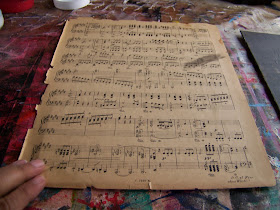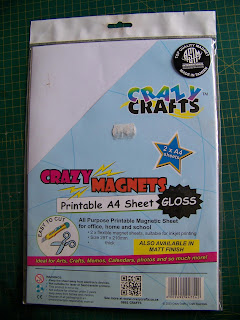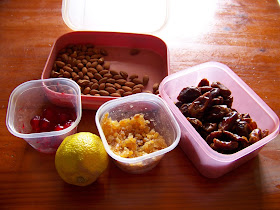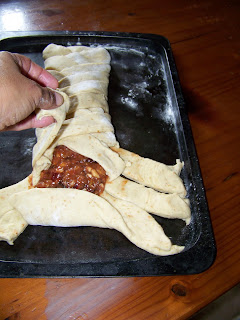I did this drawing a couple of years ago and got my proportions so wrong that I ended up hating it. I packed it away and did not give it another thought until today when I was looking for a canvas. What you are looking at is a flat canvas that has been decoupaged with sheet music. I decided to cover the drawing with black gesso and start the process over.
As there were two of these to start with, I covered both drawings with the gesso and left them to dry.
I then went in search of my sheet music. You can use new sheet music as well. I found this wonderfully aged book of sheet music in a secondhand book store and often use it in my art and craft projects. The only problem is that I have to be really careful as the paper has become quite brittle. If you can't get your hands on sheet music, try using newspaper print or even crossword puzzles, etc. Any number of backgrounds can be used with great success.
I paint a thick layer of Dala Acrylic Gel Medium on the dry gesso.
The sheet music is laid on top of the Acrylic Gel Medium and any trapped air bubbles are rubbed out.
Another thick layer of Dala Acrylic Gel Medium is then painted on top of the sheet music.
With both canvasses prepared in this way, I lay them aside to dry completely before continuing.
Once they are dry, I flip them over and use a craft knife to crop the sheet music to the same size as the A4-sized canvasses.
I use one of the designs available in the Digital Downloads tab on APrettyTalent.com, titled The Ladies. I redraw the design freehand using a Black Posca Marker with a Brush tip.
I draw a male figure in more or less the same stance on the remaining canvas, again using the Posca marker from before.
I like how these two compliment each other and decide to go ahead with the project.
I add a couple of highlights using Dala Acrylic Drawing Ink in Golden Yellow.
Though the ink comes in a drop bottle, I unscrew the tap and paint the ink on using an Angle Paint Brush.
All acrylic inks can simply be washed out with water as long as they are wet. Once the ink has dried, it is permanent.
For the red that I add, I use Daler-Rowney FW Acrylic ink in Flame Red.
Again I simply touch the areas I want to highlight.
I then use Dala Drawing Ink Process Cyan to bring a cool color to the painting.
Assessing the paintings, I decide to break away from the primary colors.
My choice of color falls on FW Acrylic Ink in Sap Green.
I decide that adding anything more would be detrimental to the paintings and leave the ink to dry.
These paintings are available from APrettyTalent.com Gallery under Miekie
These paintings are available from APrettyTalent.com Gallery under Miekie.
For more crafty ideas and great products, visit APrettyTalent.com.Remember to keep nurturing your TALENT for making PRETTY things.
You can subscribe to this blog and receive regular updates by email by simply registering your email address at the top of the current blog.














































































